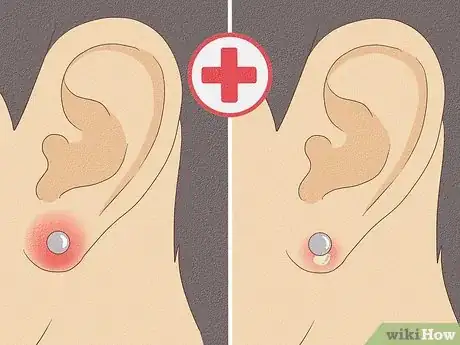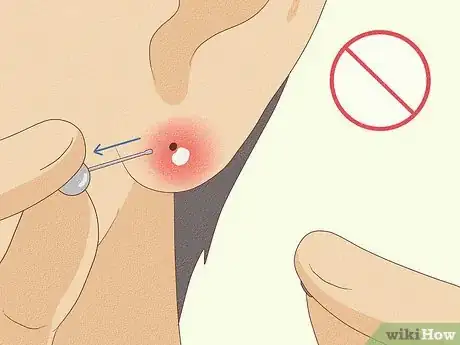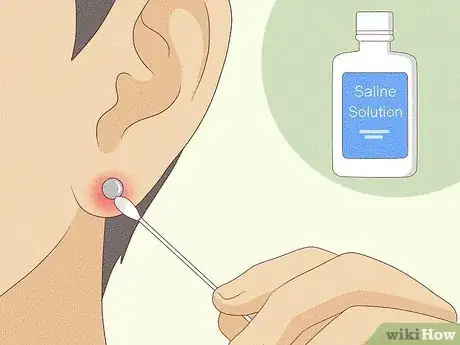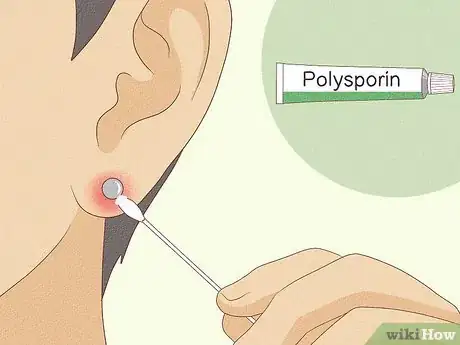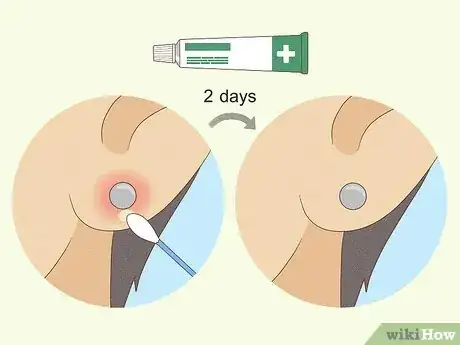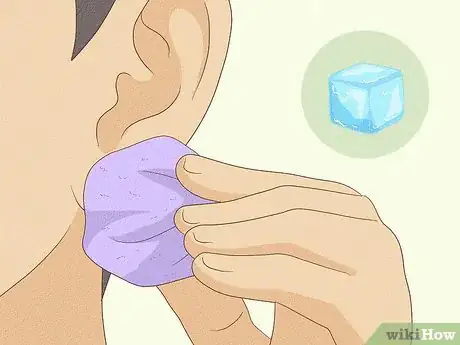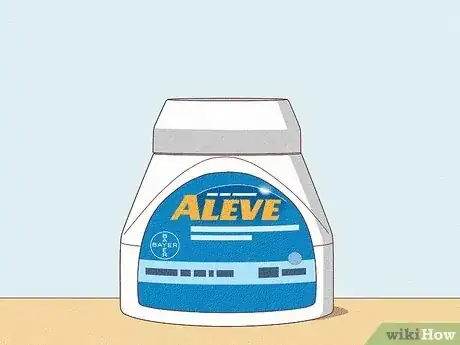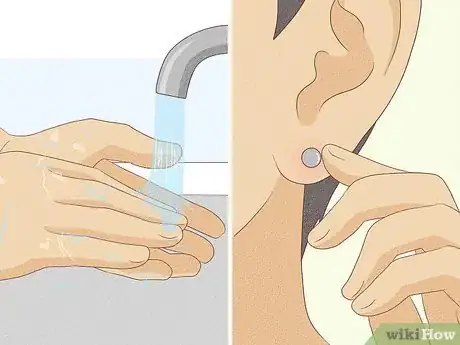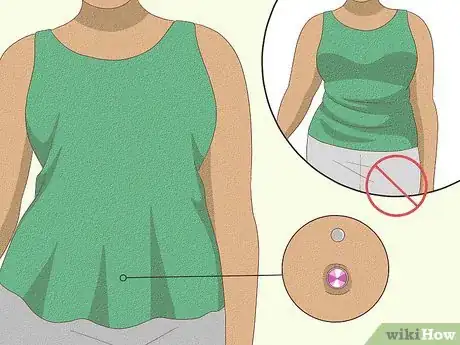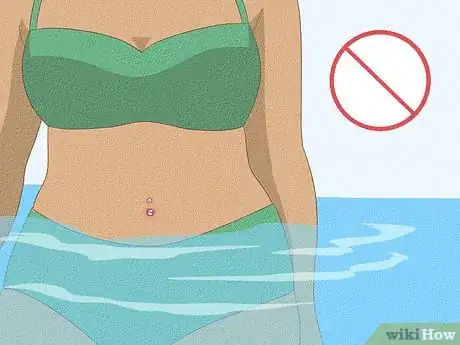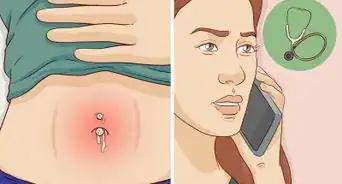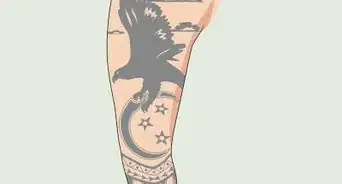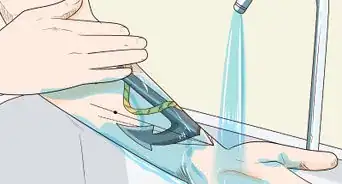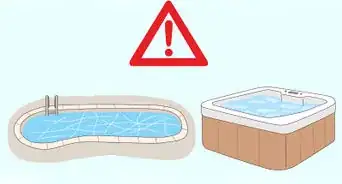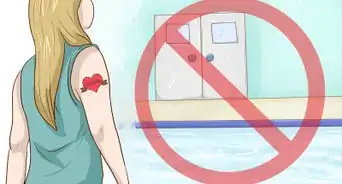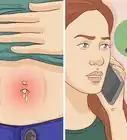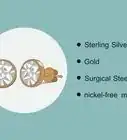This article was co-authored by Karissa Sanford and by wikiHow staff writer, Dan Hickey. Karissa Sanford is the Co-owner of Make Me Holey Body Piercing, a piercing studio based in the San Francisco Bay Area that specializes in safe and friendly body piercing. Karissa has over 10 years of piercing experience and is a member of the Association of Professional Piercers (APP).
There are 13 references cited in this article, which can be found at the bottom of the page.
wikiHow marks an article as reader-approved once it receives enough positive feedback. In this case, several readers have written to tell us that this article was helpful to them, earning it our reader-approved status.
This article has been viewed 1,267,436 times.
You’re loving the look of your new piercing, but your excitement turns to concern when you notice the initial redness and swelling aren’t going away. An infected piercing is no fun, but in most cases, you can treat them yourself at home in just a week or two with some sterile saline and an antibiotic ointment. In this article, we’ll show you how to treat and prevent piercing infections yourself, plus share ways to reduce swelling and pain while it clears up. You’ve probably got everything you need in your medicine cabinet or first aid kit already!
Things You Should Know
- Keep your piercing in and call your piercer if it’s infected. Clean it with saline and apply antibiotic ointment 3 times a day until symptoms disappear for 2 days.
- Reduce swelling and pain in infected or new piercings by applying ice, taking over-the-counter anti-inflammatories, or using a chamomile tea compress.
- Prevent infections by getting pierced by a professional. Clean the piercing twice a day, touch it as little as possible, and avoid swimming while it heals.
Steps
Treating Infections Directly
-
1Contact your piercer as soon as you notice symptoms. Mild redness, tenderness, or swelling is normal right after a new piercing, so don’t panic if you notice slight irritation. If your symptoms seem severe, call or visit your piercer right away. They can confirm if your piercing is infected and offer treatment guidelines. Symptoms of an infected piercing include:[1]
- Excessive redness or tenderness around the piercing site
- Prolonged bleeding
- A change in skin color around the piercing
- Excessive swelling
- Pus or other fluid discharge
- If a cartilage piercing is infected, skip calling your piercer and go straight to a medical doctor (cartilage infections are more difficult to treat).
-
2Keep the piercing in, even if it’s infected. It seems counterintuitive, but resist the urge to take out the piercing unless you’re told to remove it by a medical professional. If you take it out, the hole can close up and trap the infection inside your body. This makes it harder to treat, and you may have to go on oral antibiotics.[2]
- Leaving the piercing in provides an “escape route” for discharge and bacteria.
Advertisement -
3Clean the piercing 3 times a day with saline or piercing care solution. Wash your hands thoroughly, then dip a cotton swab in the solution. Gently rub all exposed parts of the piercing, plus the skin around it. If possible, rotate or turn the piercing 3 times to keep your skin from sticking to the post.[3]
- Pat the piercing dry with a clean tissue or paper towel.
-
4Apply an over-the-counter antibiotic ointment after every cleaning. Rub a tiny amount of ointment on the skin around the piercing once it’s dry, trying not to glob it on over the opening. Use any ointment you might have on hand in a first aid kit, like Neosporin or Polysporin.[4]
- The topical antibiotic will kill germs and prevent the infection from spreading further away from the piercing site.
-
5Treat the infection until symptoms are gone for 2 consecutive days. If you’re cleaning the piercing 3 times a day and following your other aftercare instructions, the infection will probably clear up in 1-2 weeks. After you’ve fully treated your infected ear piercing or other piercing, continue to clean it 2 times a day (without antibiotic ointment) until it’s fully healed.[5] Healing times for piercings include:[6]
- Earlobe, eyebrow, septum, lip, tongue, male genitals (dydoe, Prince Albert), female genitals (clitoris, labia minora): 6-8 weeks
- Nasal bridge, nipple, male genitals (hafada), female genitals (labia majora, Christina/Venus): 2-4 months
- Nostril, nose (rhino), navel, male genitals (ampallang): 6-9 months or longer
-
6Call a doctor if symptoms worsen or don’t improve after 3 days. Check your piercing daily for redness, swelling, discharge, and pain. If your symptoms aren’t clearing up, are getting more intense, or are spreading beyond the piercing site, seek medical treatment ASAP. You’ll likely be prescribed an oral antibiotic.[7] Worsening symptoms include:
- Fever
- Chills, nausea, or vomiting
- Part of the piercing is stuck inside the skin
- Redness and swelling that spreads beyond the piercing site
- Swollen lymph nodes near the piercing site
- Scarring near the piercing site
Reducing Swelling in New & Infected Piercings
-
1Ice the piercing for 15-20 minutes, several times a day. Apply a cold compress or ice pack wrapped in a cloth or towel to the piercing site to minimize swelling. Apply very light pressure, since pushing on the piercing too hard can irritate it even more.[8]
- If you don’t have an ice pack or cold compress, make your own by filling a plastic bag with crushed ice.
- To soothe lip, tongue, or cheek piercings, suck on ice cubes or popsicles, especially within the first 24-48 hours after piercing.
- Never apply ice or a cold compress directly to your bare skin.
-
2Take over-the-counter non-steroidal anti-inflammatory drugs (NSAIDs). Pick up a medication containing ibuprofen (Advil or Motrin) or naproxen (Aleve) to treat both inflammation and pain. Follow the dosage instructions carefully, and consult your doctor if you’re concerned an NSAID will interact poorly with any of your prescription medications.[9]
- If the piercing site is just sore and not swollen, try taking acetaminophen (Tylenol).
-
3Try a chamomile tea compress for its anti-inflammatory properties. Steep a bag of chamomile tea in freshly boiled water for 10 minutes, then soak a cotton pad or piece of gauze in the water. Squeeze out the excess liquid and hold the pad to the piercing site for 5-10 minutes, up to 3 times a day.[10]
- In a pinch, use the tea bag itself as a compress if you don’t have gauze or a cotton pad on hand.
- Chamomile has antimicrobial properties that can kill germs under your skin, fight inflammation, and reduce pain or soreness.[11]
Preventing Infections
-
1Get pierced by a licensed, professional piercing artist. Ignore your friend’s offer to pierce your ears at your next sleepover and research experienced, established piercers instead. Read studio reviews online and check out individual piercer’s bios and social media accounts to see if they’re legit.[12]
- Look for a clean studio, sterilized equipment, and receptiveness to your questions and concerns.
- The piercer should be transparent about their process and cleanliness standards.
- Professionals know exactly where and how to administer a piercing to minimize pain and the risk for infection later on.
-
2Wash your hands before touching or cleaning your jewelry. Resist the urge to play with your shiny new jewelry—germs from your hands are the #1 cause of piercing infections. If you must handle the piercing to change it out or clean it while it’s infected, make sure to scrub your hands thoroughly beforehand.[13]
- Wash your hands with hot water and antibacterial soap for at least 20 seconds, paying extra close attention to your fingertips and underneath your nails.
- The less you touch a fresh piercing, the faster it will heal up (and the less likely it is to get infected).
-
3Clean your piercing twice a day with saline or saltwater until it’s healed. Stay away from hydrogen peroxide, iodine, or rubbing alcohol for cleaning—these chemicals are harsh and will kill healthy, new cells in addition to bacteria. Unless there’s an infection, skip using antibiotic ointments, too (they heal outer skin and might block oxygen from getting to deeper tissue).[14]
- Use store bought sterile saline or make your own at home by mixing ¼ tsp (1.5 g) of sea salt dissolved in 8 fl oz (240 mL) of boiled water.
- To do a saltwater soak, dip your piercing in a small bowl full of saltwater or saline (or hold a saltwater-soaked cloth to it) for 5-6 minutes.
-
4Wear loose, clean clothes over body piercings and sleep in clean sheets. Try to keep dirty clothing, sheets, pillowcases, or long hair away from fresh piercings while they heal. This isn’t always practical, so make sure to always wear clean clothes, change or launder your bedding every couple of days, and try not to sleep on the side of a new piercing.[15]
- If you have long hair, tie it back to keep it out of ear, lip, nose, or eyebrow piercings.
- Ask your piercer about wearing loose gauze over body piercings to protect them from the rub of your clothes.
- Germs from dirty pillow cases can easily get into fresh ear or eyebrow piercings, and tight clothing can rub, irritate, or infect navel, genital, or nipple piercings.
-
5Stay away from pools, lakes, and oceans while your piercing heals. Minus cleaning and showering, try not to let your piercing soak in any bodies of water (not even a bathtub!) until it’s fully healed (6-8 weeks for most piercings). Water contains microorganisms, bacteria, and contaminants that can infect or irritate vulnerable, new piercings.[16]
- The older a piercing is, the better it generally holds up against water.
-
6Drink lots of water, eat a healthy diet, and get plenty of sleep. A piercing is technically an injury, so take care of your body to speed up healing and boost your immune system to fight infections. Stay hydrated, eat lots of fruits, veggies, and lean protein, and aim to get a good night’s sleep every night while your piercing heals.[17]
- Reduce your alcohol intake while you’re healing to help stay hydrated.
- Try taking a multivitamin or Vitamin C supplement for extra immune strength.
Expert Q&A
-
QuestionHow can I prepare for a piercing so it's less likely to get infected?
 Karissa SanfordKarissa Sanford is the Co-owner of Make Me Holey Body Piercing, a piercing studio based in the San Francisco Bay Area that specializes in safe and friendly body piercing. Karissa has over 10 years of piercing experience and is a member of the Association of Professional Piercers (APP).
Karissa SanfordKarissa Sanford is the Co-owner of Make Me Holey Body Piercing, a piercing studio based in the San Francisco Bay Area that specializes in safe and friendly body piercing. Karissa has over 10 years of piercing experience and is a member of the Association of Professional Piercers (APP).
Body Piercing Specialist Take care of your body—don't drink heavily or stay up late the night before the piercing. If you treat your body poorly right before you get a piercing, there's a chance your healing could be compromised.
Take care of your body—don't drink heavily or stay up late the night before the piercing. If you treat your body poorly right before you get a piercing, there's a chance your healing could be compromised. -
QuestionWhat do I do if I feel a small bump in my ear around the piercing?
 wikiHow Staff EditorThis answer was written by one of our trained team of researchers who validated it for accuracy and comprehensiveness.
wikiHow Staff EditorThis answer was written by one of our trained team of researchers who validated it for accuracy and comprehensiveness.
Staff Answer wikiHow Staff EditorStaff AnswerThe small bump might be a keloid, which is a tiny mound of scar tissue. Talk to a doctor or dermatologist about removing it, since they're difficult to treat on your own.
wikiHow Staff EditorStaff AnswerThe small bump might be a keloid, which is a tiny mound of scar tissue. Talk to a doctor or dermatologist about removing it, since they're difficult to treat on your own. -
QuestionIf my piercing is swelling 3 weeks after and I clean it 2 times a day what do I do?
 wikiHow Staff EditorThis answer was written by one of our trained team of researchers who validated it for accuracy and comprehensiveness.
wikiHow Staff EditorThis answer was written by one of our trained team of researchers who validated it for accuracy and comprehensiveness.
Staff Answer wikiHow Staff EditorStaff AnswerIf it has been swollen ever since you got it 3 weeks ago, visit a doctor to get an antibiotic prescription. If it's suddenly swelling several weeks later, it may just be a minor infection--clean it 3 times a day with saline and apply a little bit of antibiotic ointment after each cleaning until the swelling goes away.
wikiHow Staff EditorStaff AnswerIf it has been swollen ever since you got it 3 weeks ago, visit a doctor to get an antibiotic prescription. If it's suddenly swelling several weeks later, it may just be a minor infection--clean it 3 times a day with saline and apply a little bit of antibiotic ointment after each cleaning until the swelling goes away.
Warnings
- See your doctor ASAP if you notice infection symptoms in a cartilage piercing. These infections are harder to treat at home and may require antibiotics.[18]⧼thumbs_response⧽
References
- ↑ https://www.healthychildren.org/English/ages-stages/teen/Pages/body-piercings.aspx
- ↑ https://www.seattlechildrens.org/conditions/a-z/ear-piercing-symptoms/
- ↑ https://www.seattlechildrens.org/conditions/a-z/ear-piercing-symptoms/
- ↑ https://www.aafp.org/pubs/afp/issues/2005/1115/p2029.html
- ↑ https://www.seattlechildrens.org/conditions/a-z/ear-piercing-symptoms/
- ↑ https://www.mymed.com/health-wellness/body-modifications/the-complete-guide-to-body-piercing-healing-and-possible-complications/how-long-does-it-take-for-a-piercing-to-heal
- ↑ https://www.seattlechildrens.org/conditions/a-z/ear-piercing-symptoms/
- ↑ https://www.drugs.com/cg/pierced-earlobe-infection-aftercare-instructions.html
- ↑ https://authoritytattoo.com/how-to-reduce-piercing-swelling/
- ↑ https://coveteur.com/2020/01/22/proper-piercing-care-reactions-healing/
- ↑ https://www.ncbi.nlm.nih.gov/pmc/articles/PMC2995283/
- ↑ https://health.clevelandclinic.org/what-to-expect-when-getting-your-ears-pierced/
- ↑ https://uhs.berkeley.edu/health-topics/body-piercings
- ↑ https://uhs.berkeley.edu/health-topics/body-piercings
- ↑ https://www.nhs.uk/common-health-questions/lifestyle/can-i-go-swimming-after-a-piercing/
- ↑ https://www.nhs.uk/common-health-questions/lifestyle/can-i-go-swimming-after-a-piercing/
- ↑ https://www.arcadiabodypiercing.com/fresh-piercing-aftercare
- ↑ https://www.entslc.com/blog/signs-of-an-ear-piercing-infection-how-to-treat-an-infected-cartilage-or-ear-bump-in-draper-ut
About This Article
To treat an infected piercing, create a saline solution by mixing ⅛ tablespoon (1.77 g) of sea salt with a cup of water, and stirring until it dissolves. Use a clean cotton swab to dab the solution onto your piercing for 20 minutes twice a day until the infection has healed. You can also apply a cold pack to the area to reduce swelling and fight off infection. However, if the infection persists for more than 48 hours, or if you develop a fever, you should see a doctor. For help preventing an infection, keep reading!
